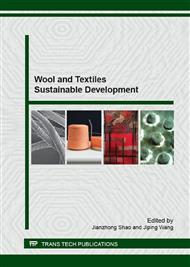[1]
J. Bartram, Improving on haves and have-nots, Nature 2008; 452(7185): 283–4.
DOI: 10.1038/452283a
Google Scholar
[2]
M. Falkenmark, Water and sustainability: a reappraisal. Environment 2008; 50(2): 4–16.
Google Scholar
[3]
M. Falkenmark, D. Molden, Wake up to realities of river basin closure. Water Resources Development 2008; 24(2): 201–215.
DOI: 10.1080/07900620701723570
Google Scholar
[4]
International Finance Corporation. Water Footprint Assessment, 2013June.
Google Scholar
[5]
A.Y. Hoekstra, Virtual water trade: proceedings of the international expert meeting on virtual water trade, Value of water research report. IHE, Delft Earthscan, Earthscan LLC, 1616 P Street, NW, Washington, DC 20036, USA (2003).
Google Scholar
[6]
F. Bulsink, A.Y. Hoekstra, M.J. Booij, The water footprint of Indonesian provinces related to the consumption of crop products. Hydrol. Earth Syst. Sci. 2010, 14 (1), 119–128.
DOI: 10.5194/hess-14-119-2010
Google Scholar
[7]
A.K. Chapagain, An improved water footprint methodology linking global consumption to local water resources: a case of Spanish tomatoes. J. Environ. Manage. 2009, 90, 1219–1228.
DOI: 10.1016/j.jenvman.2008.06.006
Google Scholar
[8]
M. Fader, D. Gerten, M. Thammer, J. Heinke, Internal and external green-blue agricultural water footprints of nations, and related water and land savings through trade. Hydrol. Earth Syst. Sci. 2011, 15 (5), 1641–1660.
DOI: 10.5194/hess-15-1641-2011
Google Scholar
[9]
A.Y. Hoekstra, A.K. Chapagain, M.M. Aldaya, M.M. Mekonnen, The water footprint assessment manual. Earthscan, Earthscan LLC, 1616 P Street, NW, Washington, DC 20036, USA.
DOI: 10.4324/9781849775526
Google Scholar
[10]
A. K. Chapagain, S. Orr., Water Footprint: The impact of the UK's food and fibre consumption on global water resources, WWF-UK, Godalming, (2008), UK.
Google Scholar
[11]
P.R. Van Oel, M.M. Mekonnen, A.Y. Hoekstra, The external water footprint of the Netherlands: Geographically-explicit quantification and impact assessment, Ecological Economics. 2009, 69(1): 82-92.
DOI: 10.1016/j.ecolecon.2009.07.014
Google Scholar
[12]
J.M. Dabrowski, , K. Murray, Agricultural impacts on water quality and implications for virtual water trading decisions, Ecological Economics. 2009, 68(4): 1074-1082.
DOI: 10.1016/j.ecolecon.2008.07.016
Google Scholar
[13]
Aldaya, M.M. and Hoekstra, A.Y. The water needed to have Italians eat pasta and pizza, Value of Water Research Report Series No. 36, UNESCO-IHE, Delft, the Netherlands, (2009).
DOI: 10.1016/j.agsy.2010.03.004
Google Scholar
[14]
F. Bulsink, A.Y. Hoekstra, M.J. Booij, The water footprint of Indonesian provinces related to the consumption of crop products, Value of Water Research Report Series No. 37, UNESCO-IHE, Delft, the Netherlands, (2009).
DOI: 10.5194/hessd-6-5115-2009
Google Scholar
[15]
P.W. Gerbens-Leenes, A.Y. Hoekstra, The water footprint of sweeteners and bio-ethanol from sugar cane, sugar beet and maize, Value of Water Research Report Series No. 38, UNESCO-IHE, Delft, the Netherlands. (2009).
DOI: 10.1016/j.envint.2011.06.006
Google Scholar
[16]
Hoekstra, A.Y., Chapagain, A. k., Aldaya, M.M., Mekonnen, M.M., Water footprint manual State of the Art 2009. p.22.
Google Scholar
[17]
Y.B. Wang, P.T. Wu, Engel, 2015. Comparison of volumetric and stress-weighted water footprint of grain products in China. Ecological Indicators 48 (2015) 324–333.
DOI: 10.1016/j.ecolind.2014.08.014
Google Scholar
[18]
S. Pfiste, S. Hellweg, The water shoesize, vs. footprint of bioenergy. Proc. Natl. Acad. Sci. U.S.A. 2009. 106, E93–E94.
DOI: 10.1073/pnas.0908069106
Google Scholar
[19]
A. Brouwer, A.J. Murk, J.H. Koeman, Biochemical and physiological approaches in ecotoxicology. Funct. Ecol. 1 990. 4: 275-281.
Google Scholar
[20]
N. Anders, Small-Scale Freshwater Toxicity Investigations: Volume 1 – Toxicity Test Methods. Christian Blaise & Jean-Franc¸ois Fe´rard (Eds), Springer Science 2005, Dordrecht, The Netherlands. xl & 906 Pp. ISBN: 1-4020-4155-1 (hardback): 197-198.
Google Scholar
[21]
Y.F. Gu, Y. Li, H.T. Wang, F.T. Li, Gray Water Footprint: Taking Quality, Quantity, and Time Effect into Consideration. Water Resour Manage 2014, 28: 3871–3874.
DOI: 10.1007/s11269-014-0695-y
Google Scholar
[22]
V. ÉRIC, G. Jeanne, F. Patrick, T. Éric, An index of effluent aquatic toxicity designed by partial least squares regression, using acute and chronic tests and expert judgments. Environmental Toxicology and Chemistry, 1999, Vol 18(10), p.2386.
DOI: 10.1002/etc.5620181037
Google Scholar
[23]
P.B. Dorne, An industrial perspective on whole effluent toxicity testing. In: Grothe DR, Dickson KL & Reed-Judkins DK (Eds) Whole Effluent Toxicity Testing: An Evaluation of Methods and Prediction of Receiving System Impact (p.16–37). (1996).
Google Scholar
[24]
R. P. Scroggins, Application of Toxicity Testing in Canadian Effluent Regulations. Effluent Ecotoxicity: A European Perspective. Society of Environmental Toxicology and Chemistry (SETAC) Conference 14–17 March 1999 Edinburgh, UK. Programme and Abstract Book. SETAC, Brussels.
Google Scholar
[25]
DTADP, Recommendations from the Direct Toxicity Assessment (DTA) Demonstration Programme Steering Group to the Regulators. (2001).
Google Scholar
[26]
US EPA. (U.S. Environmental Protection Agency). National recommended water quality criteria: p.36. (EPA-822-R-02-047). (2002).
Google Scholar
[27]
G.M. Rand, S.R. Petrocelli, Introduction. In: Rand GM & Petrocelli SR (Eds) (1985). Fundamentals of Aquatic Toxicology. Methods and Applications (p.1–28). Hemisphere Publishing Corporation, Washington, DC.
DOI: 10.2307/1310485
Google Scholar
[28]
G. Costan, N. Birmingham, C. Blaise, J.F. Ferard, Potential ecotoxic probe (PEEP): A novel index to assess and compare the toxic potential of industrial effluents. Environ Toxicol Water Qual. 1997, 8: 115–140.
DOI: 10.1002/tox.2530080202
Google Scholar


